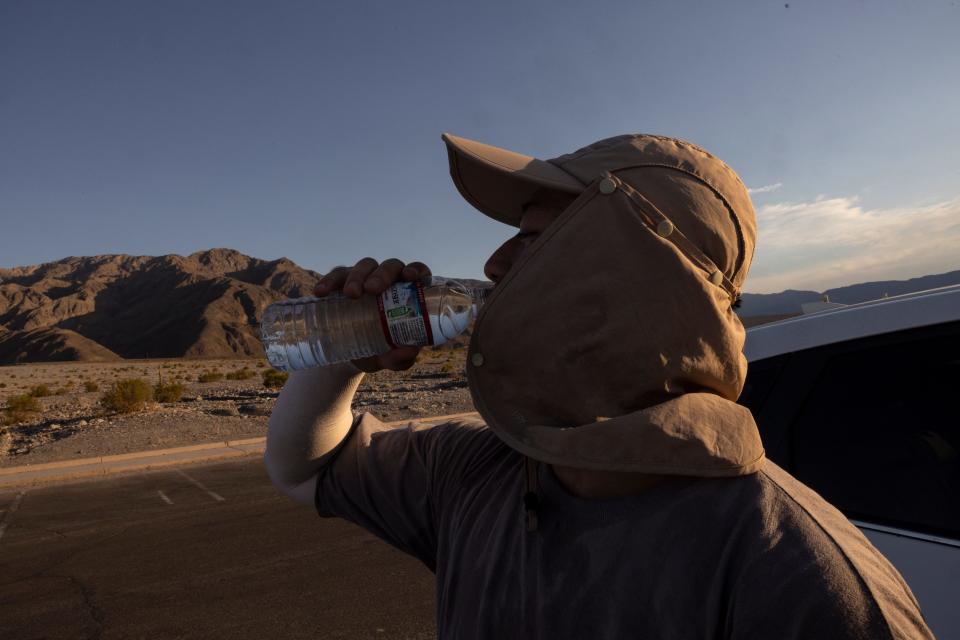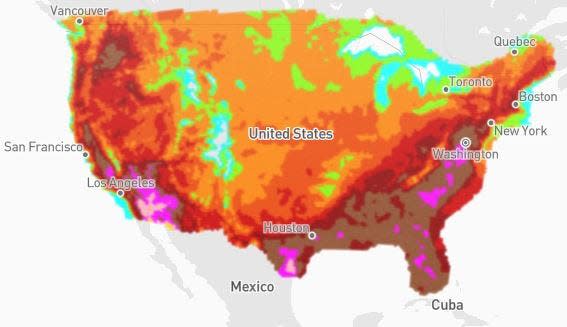It is way too hot. 160 million under alert as heat breaks records and a bridge
Americans across much of the country are thinking the same thing as temperatures keep breaking records and heat indexes soar into the triple digits: It is way too hot.
Over 160 million Americans were under some kind of excessive heat alert on Tuesday, according to Heat.gov. Oppressive heat is blanketing the western U.S. and large swaths of the South, Southeast, Mid-Atlantic and southern New England.
Temperatures between 10 and 30 degrees above average are expected across virtually all of Washington, Oregon, California, Nevada and western Arizona. Boise, Idaho, is slated to hit 109 degrees on Wednesday. Heading eastward, heat indexes in parts of northeast New Jersey could hit heat 105 degrees.
"The multi-day length and record warm overnight temperatures will continue to cause heat stress to anyone without adequate cooling and hydration," the weather service said.
It's so hot that record high and overnight low temperatures are being broken, rescue helicopters have been grounded and infrastructure has been rendered inoperable.

5 dead as heat wave blankets the West
The recent heat wave in the western part of the country has claimed at least five lives so far, officials have said.
On Monday, Phoenix broke its record for high daily temperature by 3 degrees when it hit 118. The old record was set in 1985. In Oregon, parts of the Willamette Valley are on the verge of tying or breaking a record for consecutive days over 100 degrees set in 1941. Las Vegas recorded its hottest temperature ever on Sunday at 120 degrees.
In Multnomah County, Oregon, which declared a state of emergency because of the heat in recent days, four people are suspected to have died of heat-related illness since Friday, according to the county coroner. An 87-year-old man died Friday; a 33-year-old man died Saturday at a Portland hospital of suspected heat illness; and a 64-year-old man and a 75-year-old man died Sunday in different parts of the county. The county hasn't seen the worst yet, with high temperatures expected to peak Tuesday.

As temperatures in Death Valley National Park soared to 128 degrees on Saturday, a motorcyclist died and another was hospitalized. Temperatures were so high that a rescue helicopter couldn't help the group because it couldn't fly when it reached over 120 degrees.
See how hot it is across the US
After Beryl rips through Houston, residents without power in soaring temps
Tropical Storm Beryl's devastation left over 2 million people in the Houston area without power. That means they don't have air conditioning as temperatures are set to reach dangerous levels on Tuesday.
While CenterPoint Energy said it was working to restore power to 1 million households by the end of Tuesday, temperatures were forecasted to reach the low 90s with a heat index that could hit 106 degrees.
The weather service said the heat index would normally not warrant a heat advisory in the area, but widespread outages make it especially dangerous. Those still without power and anyone working outside to clean up the damage caused by the storm is at increased risk for heat illness.
3rd-degree pavement burns spike in Las Vegas
In Las Vegas, where the high temperature is expected to reach 114 degrees Tuesday, the burn care team at University Medical Center is “incredibly busy” treating a massive spike in pavement burns, Director of Public Relations Scott Kerbs told USA TODAY.
“We continue to see new pavement burn patients every day,” Kerbs told USA TODAY.
Such burns typically happen after someone lies on pavement, which in recent days has been as hot as 170 degrees, Kerbs said. After being hospitalized, treatment and skin graft surgeries can take weeks or months.
Pavement burns have increased by more than seven times from last summer, Kerbs said. Last June, three people were treated for pavement burns, but this June, there were 23 cases.
“The most important thing is to stay hydrated, monitor how you’re feeling, seek shade whenever you possibly can, and know your limits,” Kerbs said.
-Claire Thornton, USA TODAY
Heat causes New York bridge to seize up
A bridge in New York literally couldn't take the heat and stopped working as temperatures soared Monday, stopping just short of three digits.
The Third Avenue Bridge connecting the Bronx and Manhattan was shut down after it got stuck halfway open due to overheating machinery, the Fire Department of New York said. Marine units with the department were called to water down the hydraulics at about 2:45 p.m. Monday, the FDNY said, with the operation going on until almost 6:45 p.m. The bridge was closed for all traffic during this time.
Video footage from the incident shows the 126-year-old swing bridge halfway open as boats spray water on it in an attempt to cool it down.
-Saman Shafiq, USA TODAY
Contributing: Minnah Arshad, USA TODAY; Bryce Buyakie, USA TODAY Network
This article originally appeared on USA TODAY: Extreme heat warning as oppressive temperatures bake US


